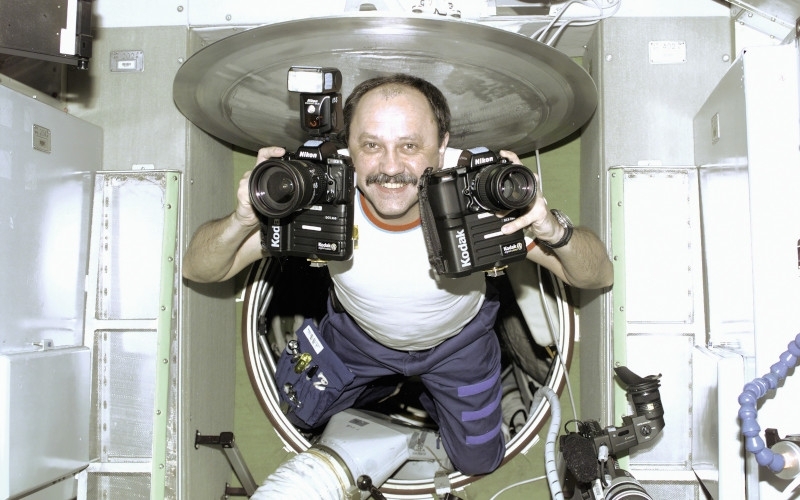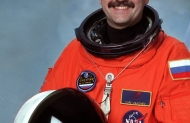
Young correspondents of the Happiness Department of the Eurasian Peoples’ Assembly asked questions to cosmonaut Yuri Usachev, a veteran of four space flights, including two long-term missions aboard the Mir space station and another on board the International Space Station.
Yuri Usachev, answering the question about happiness, said important words:
"When you are isolated and realize that you can move to another dimension very quickly, the scale of life perception and habitual values inevitably changes. What seems very serious and important to you on Earth, in space you realize that this is nonsense, which is not even worth the effort invested."
- All work in space begins with work on Earth - both your work and the work of those specialists who provide your flights, they are involved in this case, that is, they are in some sense also astronauts. What should happen that these people feel "get sick" of the cosmos, feel their involvement? How does this happen?
- It's hard to say, after all, involvement is formed gradually, it takes time to feel this connection and feel, let's say, proportionate. Perhaps this is due to some events in life that leave a certain trace.
In my case, it probably started in childhood. I had a lot of toys, and among them was a small rocket made of durable plastic, hollow inside. Included with it was a conventional pump, but with a perpendicular nozzle. A little water was poured from the watering can into the rocket, then with the help of a rubber seal it was attached to the pump — and it was possible to pump. And then this rocket took off, throwing off water. It's not like if you pump air, it's closer to jet propulsion. Apparently, such things can also leave their mark.
Already being an astronaut, although at first I wanted to become a pilot, I tried to understand and analyze where it came from — such a desire. And I remembered that we were sent as children to the Krasnodar Territory, to the Kushchevsky district. Now it is notorious, and then there was an aviation unit right in Kushchevskaya, where they "taught Democrats to fly," as they said then, or Africans - one of these guys. So, MiG-21s with a triangular wing and “Sushki” regularly flew over the village. These roaring planes flew in pairs quite low. Perhaps this also influenced, and also the situation that was in the country, there was a desire to be like the people who are in these aircrafts...
Probably, such impressions sink into the child's consciousness at first as a dream, and then gradually transform into more conscious desires. I think it's even better when there are people who can form such aspirations. But I was so unlucky. Cosmonauts were definitely inaccessible on the periphery at that time, they were practically celestials.
- How can public organizations raise interest in the space topic among our youth?
- In my opinion, there are several ways. Of course, it is possible through public organizations. But it is clear that such organizations have fewer opportunities than the same DOSAAF, which was before. If this is a state task (and the training of pilots should be a state task), they need to be selected, trained, not everyone will pass a medical examination yet… It should be a system, and it is better if the state does it.
There have been many changes over the past 30 years: DOSAAF has gone, and the country has changed. Thank God that in many areas there are enthusiasts who have enough restlessness, curiosity or desire to do something very serious! And they continue these traditions and do, it would seem, in spite of. There are a lot of things that hold on to such enthusiasts in the country.
The most paradoxical thing is that, unfortunately, the state often does not support these people too much. Although, it would seem that you have a person who invests time and effort to solve problems that officials should solve. So help him a little, give him money, equipment, and he will solve his task more effectively! But, in a good way, if we are talking about a serious approach, it should be a state system - with organization, with financing, with personnel, with equipment, and so on.
- How can scientific and technical creativity help future aircraft designers, creators of spacecraft?
- Again, I can only refer to my own experience. We had an airplane modeling club in the city, I don't remember who dragged me there around the first or second grade. The city was a mining town - and the Palace of culture "Miner", there was a club for mine workers. And I remember very well the sensations, smells, glue, rubber-engine models, the body of an airplane made of some light wood, which was pasted with tissue paper, then the rubber was wound up and launched. And there were also those who made cord models with a motor — this was already considered aerobatics!
All these are also, probably, bricks, from which something serious can develop. It is not necessary that all these boys will grow up to be aircraft builders, but it will still sink into someone's soul. People learn to work with their hands and heads, in a team, older and younger. I think it was a very good experience, which, unfortunately, we lost. Now we are trying to get it back through the "Quantorium".
- Since you mentioned "Quantorium"... what do you think about this project?
- It is very good that there is such a platform where the guys have the opportunity not to do something like we did on the knee, but already at a new technological level, with good equipment, to do something serious. I think that for many it will also be a stepping stone to something more serious. Of course, a lot will depend on the guys themselves who are doing this. But no less from a teacher who can instill in them the desire to continue doing this and grow.
- Please tell us about the experience of your first flight.
- I think that this is exactly the case when emotions… It is also worth preparing for this, so that a person gets the maximum joy and pleasure from flying. But what he feels will be stronger than any stories.
Again, I can only say about myself. From my small mining town, which was 170 kilometers from Rostov-on-Don, the bus took about five hours. One stop, another, and if you were going to go in the morning, got dressed at six o'clock, then by twelve o'clock, God willing, you reached Rostov.
Then the AN-2 plane was still flying. Now this field remains, almost overgrown, but there is practically no airfield, there are no planes either. I flew several times, again as a boy. It took 45 minutes. I remember very well the metal chairs that stood along the sides, and not perpendicular - and very badly, otherwise I probably would have seen the field. But this bumpiness, these pits that were very well felt there - it remains in the memory; this is the feeling of flight. Maybe it's not necessary to say too many words, but it's enough for a person to just feel it. Then these feelings will work more and better than any words.
Read more about happiness, space and flights in the issue of the Happiness Aggregator magazine.



